Edinburgh and District Tramways
History
The Edinburgh and District Tramways Company was registered on the 6th March 1894 by Dick Kerr and Company Limited of Kilmarnock, expressly to take over the horse-tramway services that it was operating on behalf of Edinburgh Corporation, the latter having compulsorily purchased the lines (and assets) of the Edinburgh Street Tramways Company within its municipal boundary. The corporation had taken possession of its new tramway on the 9th December 1893, the 70 standard-gauge horsecars and 600 horses it had acquired from the ESTCo being immediately sold to DK&Co, which had been awarded a 21-year lease of the system. It did, however, take some time to structurally and operationally separate the new DK&Co assets from those of the much-reduced ESTCo, the latter continuing to operate horse-tramway services within Leith and Portobello.
The corporation lease was formally transferred from DK&Co to its new subsidiary, the E&DTCo, in July 1894, though crucially, the transfer was never ratified by the Board of Trade, which was to have consequences later.
The corporation take-over caused operational chaos at the Edinburgh/Leith municipal boundary at Pilrig, horses and crews having to be changed whilst passengers sat in the horse trams, which were worked through from one company's territory into the other's. DK&Co attempted to resolve this by purchasing the ESTCo, but could not agree to the latter's demand that all its assets be purchased, including its horse bus operations. Another changeover headache was added into the mix on the 31st January 1896, with Edinburgh Corporation's purchase of the Waterloo Place to Jocks Lodge section of the ESTCo's Portobello line.
Edinburgh Corporation intended to convert its newly acquired tramway to cable operation — powers having been obtained on the 29th June 1893 under the Edinburgh Corporation Tramways Act 1893 — and in March 1896, it accepted the tender of DK&Co for the reconstruction of the system. Powers for extensions to the existing system were subsequently obtained on the 7th August 1896 under the Edinburgh Improvement and Tramways Act 1896, with construction formally starting one month later, on the 9th September 1896.
The corporation's planned cable system was not, however, the first in Edinburgh, this accolade going to the Edinburgh Northern Tramways Company, which operated 2.61 miles of standard-gauge cable tramway to the north of Princes Street, its first services having started as early as the 29th January 1888. The success of the system no doubt played a critical role in convincing the corporation to adopt this mode of traction, which though expensive to construct, was eminently suitable for the steep gradients within the city. The ENTCo's two lines lay wholly within Edinburgh, and were presumably not purchased at the same time as the ESTCo's line, as they had been constructed under an Act of 1884, so could not be compulsorily purchased until 1905 (i.e., 21 years after authorisation). In 1896, however, the corporation reached agreement with the ENTCo to purchase the tramway, though it would first have to acquire the powers to do so. Rather than wait for these powers, the ENTCo agreed to hand over operation to the E&DTCo, which it did on the 1st January 1897. DK&Co were presumably instrumental in this agreement, as they not only controlled the E&DTCo, but very possibly the ENTCo too (at the very least they were a significant shareholder). The corporation duly obtained powers to acquire the tramway on the 3rd June 1897, under the Edinburgh Corporation Act 1897, the undertaking passing into corporation ownership on the 1st July 1897, with the cable trams being immediately sold to the lessee, the E&DTCo. The 1897 Act also contained powers for additional extensions and modifications to the planned cable-tramway system.
The E&DTCo's operational mileage expanded once again, on the 30th June 1898, with the corporation's purchase of the remainder of the ESTCo's Portobello line (Jocks Lodge to Joppa), horse tramway services thereafter being worked through without a change of horses and men. The following day, the E&DTCo commenced a new 21-year lease of the system, the old unratified, and therefore legally questionable lease having put paid to yet another attempt to reunify the tramway systems in Edinburgh and Leith, which would have involved Leith Corporation purchasing the ESTCo's lines within its municipal boundary, and leasing them to the E&DTCo.
On the 18th December 1897, the first of the new lines and extensions were opened, using horse traction: Ardmillan Terrace to Gorgie; Coatbridge to Murrayfield; London Road to Abbey Hill; Morningside to Braid Hills; Powburn to Nether Liberton; and Tollcross, via Melville Drive, to Marchmont. These were followed, on the 1st June 1899, by a line between Strathearn Road and Strathearn Place.
Trials of the new cable trams began on the 1st June 1899, with the first officially sanctioned services starting on the 26th October 1899 between Pilrig and Braid Hills Road, thus putting paid to through-running between Edinburgh and Leith. The remaining lines of the new cable system opened in stages during 1900, with the last line — to Portobello and Joppa —opening on the 1st May 1902. The line along Colinton Road to Craiglockhart remained, for the time being, horse drawn.
The opening of the new system was not without its operational challenges, especially the procedure for negotiating complex junctions where cables crossed, trams having to release one cable, and take up another, sometimes more than once, especially where an auxiliary cable had been installed specifically for this purpose. Edinburgh was the only tramway in the British Isles to use cable traction for an entire system, rather than isolated lines, so was the only one to have to deal with this degree of complexity. There were significant issues with the auxiliary cables, the E&DTCo claiming that their use was impractical, which led to the company withdrawing some services that necessitated their use, including the popular 'inner circle' service, passengers having to change cars to continue their journey where this had not been the case previously. Although this displeased the corporation, which insisted on them being reintroduced, the company was at that time set on a collision course with the council, defaulting on its payments in 1900 (which including an eye-watering 7% of the council's capital costs per annum), and introducing Sunday services (against the council's wishes) in 1901. A compromise was eventually reached on all these matters, and the system gradually settled down, cable cars coasting over some junctions, rather than picking up and releasing multiple cables.
On the 4th August 1906, powers for conversion of the Craiglockhart line, as well as a new line between Broughton Street and Canonmills, were obtained under the Edinburgh Corporation Act 1906. However, doubts now began to surface within the corporation as to the wisdom of building further cable lines; not only were they extremely expensive to construct, but they were now seen as 'old technology' in comparison to electric traction. The council was, however, opposed to overhead electric traction on the grounds of civic disfigurement, so investigated the various surface-contact options then in use around Britain. In the end, however, it was felt that a mix of surface contact and cable would simply be too challenging to install, and to top that, the E&DTCo made it clear that it was not at all interested in operating a mix of the two. In February 1907, the council therefore decided that the Craiglockhart and the Broughton Street to Canonmills lines would be converted to cable traction.
The last horse trams to run in Edinburgh, on the Craiglockhart line, were withdrawn on the 24th August 1907, the new cable services commencing on the 7th April 1908. These were followed six months later, on the 20th October 1908, by the introduction of cable services on the Broughton Street to Canonmills line. Barely two years later, however, the pendulum had swung fully over to overhead electric traction, the council deciding to build a new line out from Ardmillan Terrace to Slateford using this mode of traction. The choice of the latter was also influenced by a planned connection to the Colinton Tramways Company's proposed overhead electric tramway at Slateford, which was, however, never built. The new line was opened on the 8th June 1910, but was operated by the E&DTCo under a separate lease, which was timed to end with the main 21-year lease on the 30th June 1919.
On the 31st October 1912, the council decided that it would work the tramway system itself (after the lease ended in 1919), a subsequent report by the borough engineer recommending a mix of overhead electric tramway and motorbus services, powers for the latter, including operation outside the municipal boundary, being obtained on the 15th August 1913 under the Edinburgh Corporation Act 1913. Although the first motorbus services were introduced on the 3rd August 1914 — operated at cost by the E&DTCo — they lasted barely three months before withdrawal, most of the vehicles having been requisitioned by the War Department.
The system dramatically deteriorated during the Great War, suffering from a loss of skilled men to the armed services, government restrictions on spares and new materials, and heavy passenger loadings, all of which impacted infrastructure that was approaching the end of its useful working life. A measure of the neglected state of the tramway comes from a corporation-commissioned independent report into the tramcar fleet, which in May in 1916 found that only two trams out of a fleet of circa 200 vehicles, were described as 'in order'. An effort was made to improve the situation, which was partially successful, the tramway limping on through the war, towards its impending replacement.
Meanwhile, on the 17th May 1916, the corporation obtained powers for extensions to the system (under the Edinburgh Corporation Order Confirmation Act 1916), though these all had to wait for the conclusion of the conflict.
The last day the E&DTCo's lease was the 30th June 1919, the entire system being handed over to the corporation the following day.
At its maximum, the E&DTCo operated 18.65 miles of standard-gauge tramway, the majority of it using cable traction, but with circa 1.2 miles of overhead electric traction. From Princes Street, lines ran: northwards to Goldenacre; northeastwards to Pilrig; eastwards to Joppa; southeastwards to Nether Liberton; southwards to Marchmont and Braid Hills; southwestwards to Craiglockhart, Slateford and Gorgie; westwards to Murrayfield; and northwestwards to Comely Bank. There were also a significant number of interconnecting lines.
Uniforms
Crews working the horse services wore single-breasted jackets with four buttons (bearing the full company title and a triple towered castle device — see link) and lapels, the collars bore 'E D T' system initials in individual metal letters, probably nickel to match the buttons. The caps were in a kepi style and were plain, i.e., they bore no cap badges. A distinct line ran around the circumference (approximately two-thirds the way up), which may have been a join, or possibly piping of a colour that is hardly distinguishable from the cap material itself.
In the 1900s, the style of the jackets changed subtly; they were still single-breasted, but now had high, fold-over collars (bearing the usual 'E D T' system initials), and a square cut at the bottom rather than the rounded one used previously. Large nickel cap badges were also introduced, probably around 1904, to reflect the new era of cable-hauled traction, and appear to have been issued to staff working all services, including those on the horse trams. These badges bore 'E. D. T.' system initials above the grade — either 'DRIVER' or 'CONDUCTOR' — with the bearer's class below: 'CLASS 1', 'CLASS 2', or 'CLASS 3' (see photos below).
Crews working the initial cable-hauled services — taken over from the Edinburgh Northern Tramways Company in 1897 — appear to have worn the same style of uniforms as those worn by the horse tram crews. However, at some point following the introduction of the newly converted cable lines, drivers and conductors were issued with double-breasted, lancer-style tunics with five buttons and stand-up collars; the latter carried an employee number in individual metal numerals on the bearer's right-hand side only. The caps were initially soft-topped with a peak, but were eventually superseded by tensioned-crown peaked caps; both types carried an elaborate new cap badge (these were also issued to horse-tram crews [see above]). In early 1913 the nickel cap badges were replaced by a new design — in brass — which comprised the company title and bearer's grade (within brass ribbons inlaid with blue enamel). In the centre were the arms of Edinburgh above an oval, within which was either a vertical bar, a crescent or a diamond, the symbols denoting the class of the bearer (i.e., 1, 2, or 3). Although there is currently no evidence available to indicate which symbol denoted which class, it has been suggested that they ran in alphabetical order, i.e., Bar, Crescent, Diamond, though this begs the rather obvious question of why they didn't start with an 'A'. Research by Alan Brotchie reveals that the classes were based on the length of service, and that the clear marking of the classes (on the early badges) became contentious, the men eventually persuading the company to replace them with new badges bearing symbols, the meaning of which was not evident to the travelling pubic.
The jacket buttons were presumably changed to brass to match the new cap badges.
From 1910 onwards, the E&DTCo also operated an overhead electric line from Ardmillan Terrace to Slateford — staff working these services wore the same uniforms as their colleagues on the cable-hauled trams.
Drivers and conductors were also issued with long, double-breasted greatcoats with five pairs of buttons, high, fold-over collars and epaulettes; the latter probably bore an employee number.
At the end of 1908, long-service stripes were applied to uniforms ( a stripe denoted 10-years service), and a scheme was introduced that recognised conspicuous action through the awarding of a merit medal.
Inspectors were initially issued with long single-breasted overcoats with lapels, the collars bearing the grade — 'Inspector' — in embroidered script lettering. Caps were identical to those worn by tramcar staff, i.e., kepis with piping of a lighter colour around the circumference (approximately two-thirds of the way up), but with no badge. It is currently unclear what uniforms were worn from the Edwardian era through to the take-over of the E&DTCo in 1919.
In common with the vast majority of UK tramways, the E&DTCo employed female staff during the Great War to replace men lost to the armed services. The first group started work on Saturday 12th June 1915 as conductresses, and by the 5th April 1916, 227 were thus employed in Edinburgh as a whole (inclusive of bus conductresses). Women were never employed to drive the E&DTCo's trams, the vast majority of which were cable cars. The conductresses were issued with long skirts and tailored, single-breasted jackets with six buttons, four pockets (with button closures), stand-up collars and epaulettes; the collars bore an employee number on both sides in individual numerals, probably brass by this time. Caps were in an unusually wide-crowned (topped) peaked style, though one photo does show a more fashionable baggy motor cap, which may have superseded the wide-crown variety; the caps carried the same brass and blue enamel cap badges that were issued to their male colleagues. The ladies were also issued with long, double-breasted greatcoats with six pairs of buttons, upturned cuffs (with two buttons) epaulettes and high, fold-over collars; the collars and the edges of the coat were piped, but no badges of any kind appear to have been carried.
The official reports of the Hackney Carriage Inspector for Edinburgh have fortunately survived, the one from 30th July 1919 being particularly revealing as it shows the change in male/female employment following the end of the war (1917/8 versus 1918/19). Male driver numbers rose from 369 to 469, whilst women drivers remained static at 12, all of whom were employed as motorwomen on the Musselburgh & District Tramways Company's Joppa line. The situation with conductors was much starker, the number of men rising from 125 to 246, with women falling from 441 to 375. I am indebted to Alan Brotchie for this information.
Further reading
For a detailed history of the Edinburgh and District Tramways Company, see: 'Edinburgh's Transport - Volume 1, The Early Years' by D L G Hunter; The Mercat Press (1992).
My thanks go to Alan Brotchie for supplying virtually all of the excellent photographs below, and much of the background information.
Images
Horse tram drivers and conductors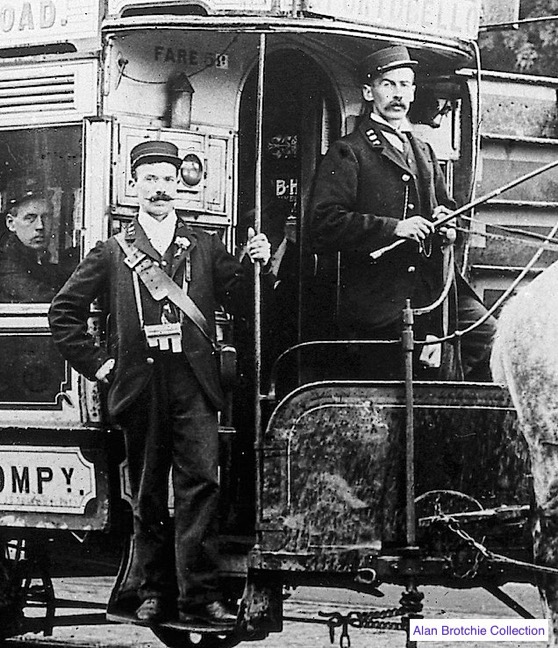
An Edinburgh and District Tramways Company conductor and a driver aboard Horsecar No 80 at the Colinton Road terminus — photo undated, but probably taken in 1899.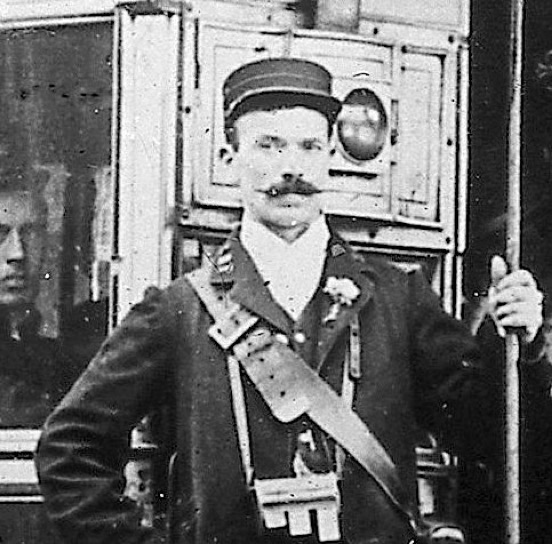
An enlargement of the above photograph showing the conductor. Apart from the company buttons, the only insignia are the individual nickel 'E D T' initials worn on the jacket collars.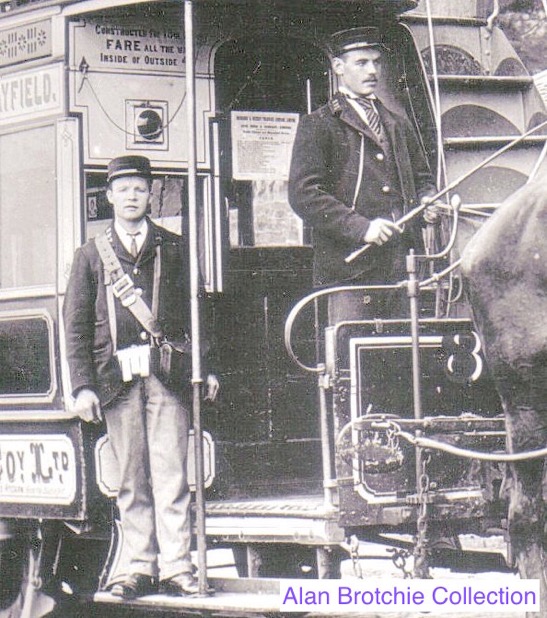
A conductor and a driver with Horsecar No 88 at the Murrayfield terminus circa 1900. 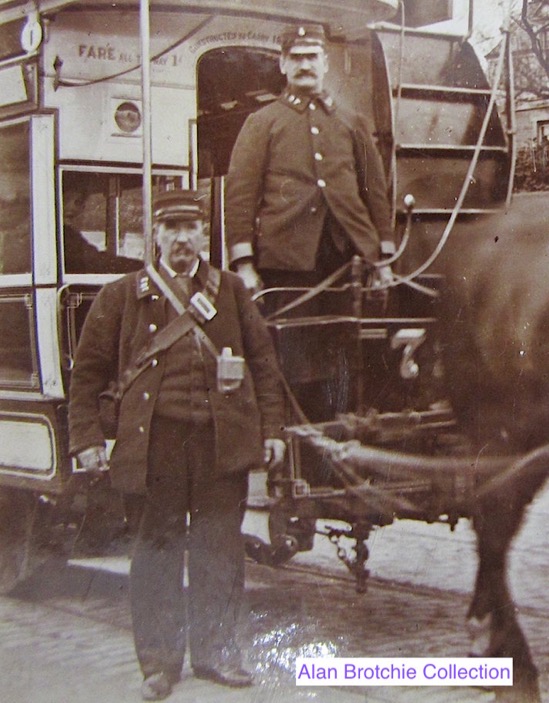
The crew of Horsecar No 72 pose for the camera with a Tollcross to Colinton Road service — photo undated, but probably taken between 1902 and 1904. Both men are wearing jackets without lapels, and with a square cut at the bottom rather than the rounder one of the earlier jackets.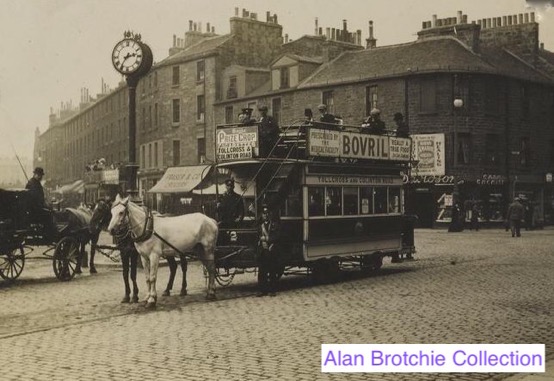
A shot of the last day of horse tram operation — 24th August 1907. Both men are wearing the newer style cap badges introduced with the cable trams (see below).
Cable tram drivers and conductors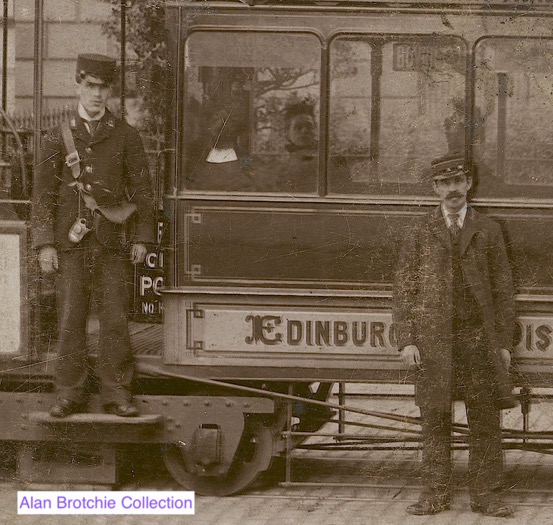
An E&DTCo conductor and an inspector pose for the cameraman in Inverleith Row with an ex-Edinburgh Northern Tramways Company cable tram — photo undated, but probably taken not long after the take-over of the ENTCo in 1897. Both men are wearing uniforms identical to those worn by E&DTCo horse-tram crews, lacking the cap badge worn by staff of the former ENTCo (see link).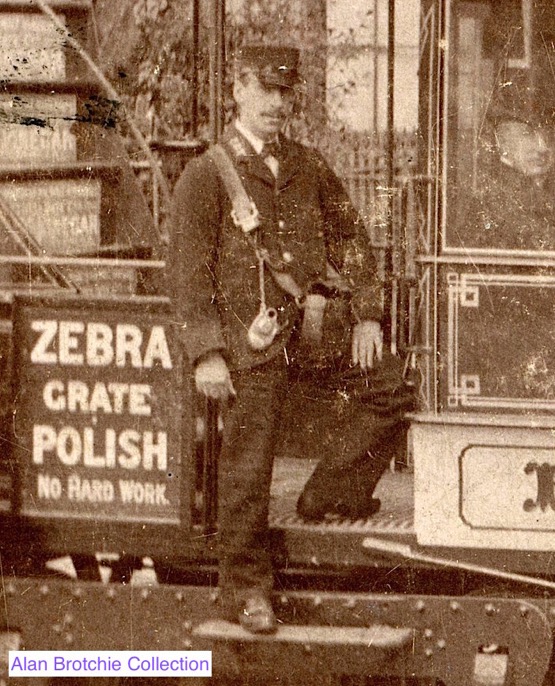
An E&DTCo cable tram conductor, taken at the same location as above, possibly on the same day, wearing a typical E&DTCo horse tram crew uniform.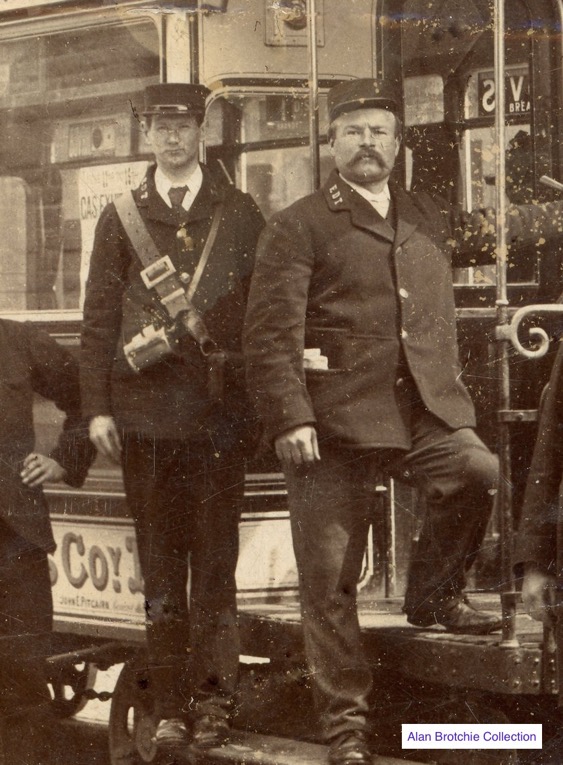
The crew of Cable Tram No 2 at the top of Marchmont Road, very likely taken in May 1900, shortly after the line's conversion. Both men are wearing the standard E&DTCo uniform.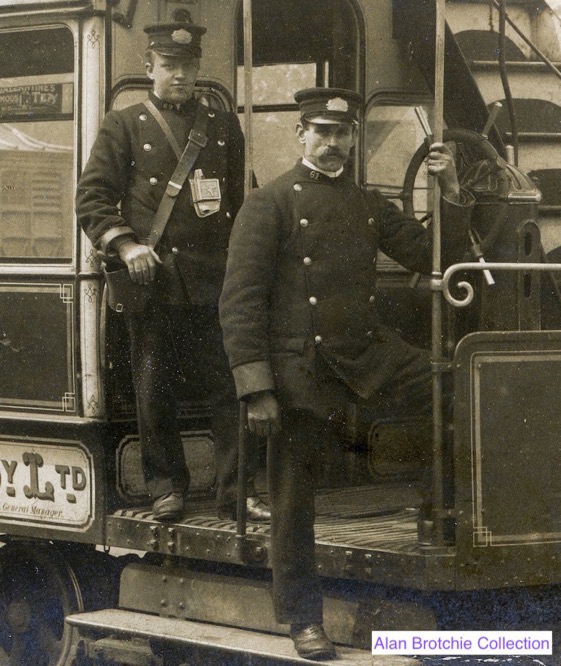
A nice, sharp study of Conductor 62 and Driver 61 with Cable Tram No 194 on a service for Gorgie via St Andrew Street. This view is particularly significant as it has been postally used, so must have been taken prior to the 3rd July 1904. Both subjects are wearing a completely new lancer-style jacket, along with soft-topped caps peaked caps and elaborate cap badges, presumably introduced during (or shortly after) the major conversions to cable haulage.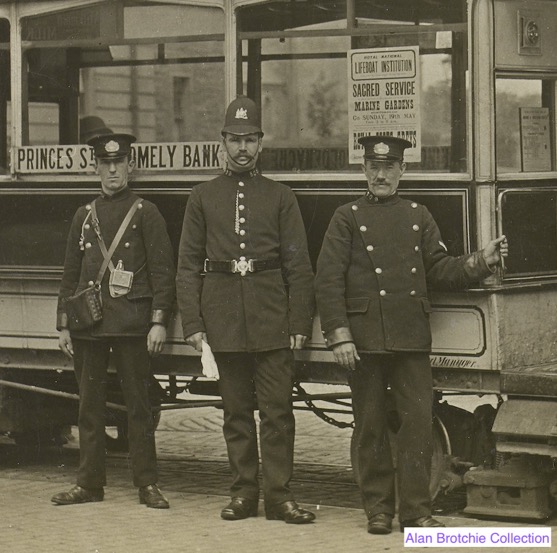
A cable tram conductor (left) and his driver (right) flank a policeman at Comely Bank. The photo can be dated fairly accurately as the Sacred Service at the Lifeboat Institution took place on the 19th May 1912; my thanks to Joe Rock for this information.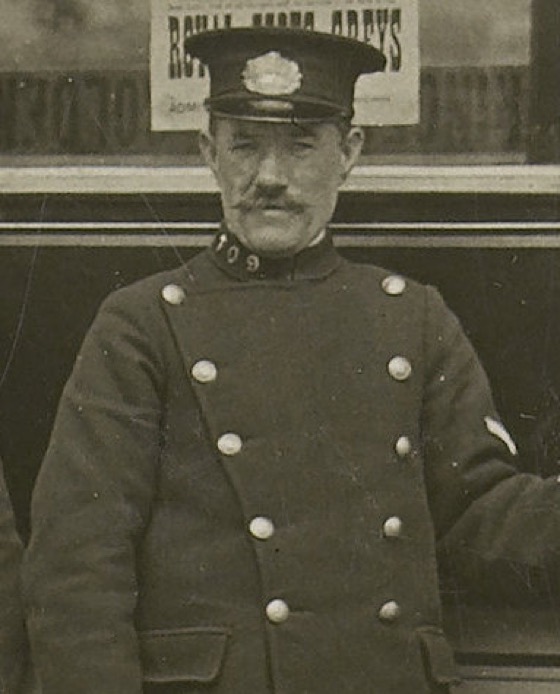
An enlargement of the above photograph, which clearly shows the distinctive cap badges (and tensioned-crown peaked caps) used throughout most if not all the Edwardian era, as well as the employee number on the collar (109). The chevron on the left-hand jacket sleeve of the driver signifies long service.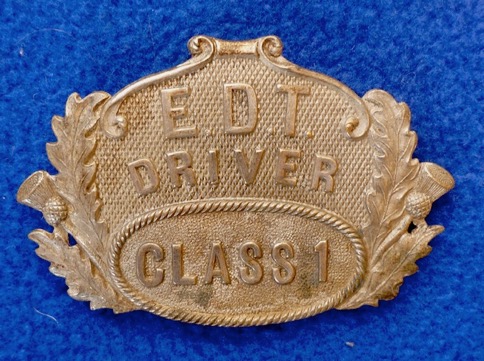
A 'CLASS 1' EDTCo 'DRIVER' cap badge — nickel. These appear to have been issued to all tram staff following the introduction of the new E&DTCo cable tram services, and lasted through to 1913. Author's Collection.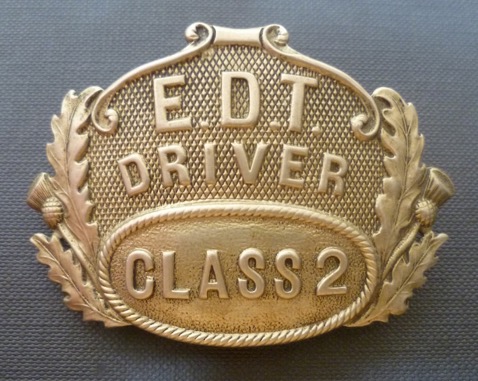
A 'CLASS 2' EDTCo 'DRIVER' cap badge (c1897-1913) — nickel. Author's Collection.
Another enlargement of the Comely Bank photograph above, this time showing the conductor.
A 'CLASS 1 EDTCo 'CONDUCTOR' cap badge (c1897-1913) — nickel. John Lodge Collection.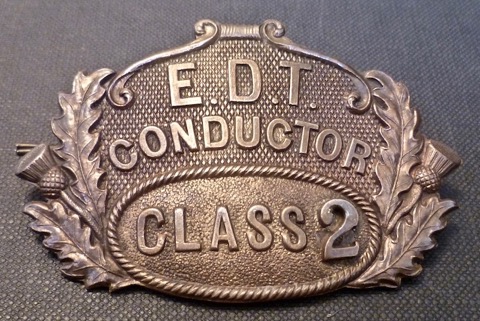
A 'CLASS 2' EDTCo 'CONDUCTOR' cap badge (c1897-1913) — nickel. This example is actually a 'CLASS 3' badge that has had a '2' soldered onto the front, suggesting that badges were at times re-purposed for different classes. The heat has imbued the badge was a bronze hue. Author's Collection.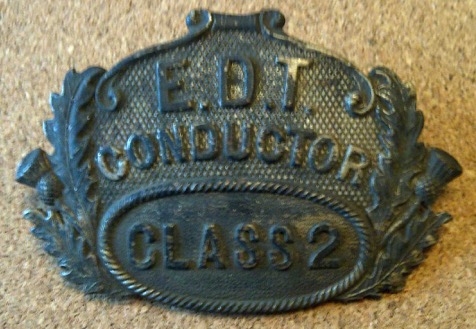
A 'CLASS 2 EDTCo 'CONDUCTOR' cap badge (c1897-1913) — nickel. John Lodge Collection.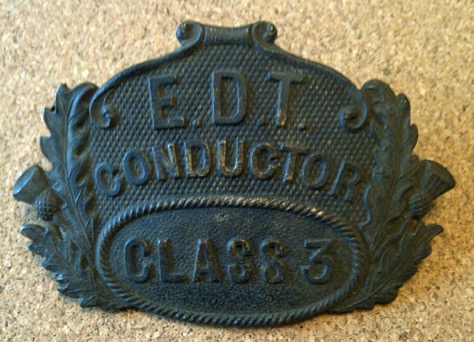
A 'CLASS 3' EDTCo 'CONDUCTOR' cap badge (c1897-1913) — nickel. John Lodge Collection.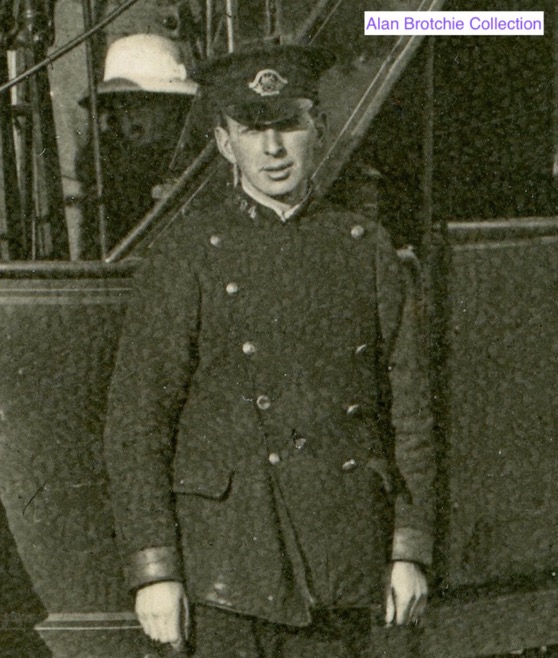
A cable tram driver (possibly Employee No 294) poses for the cameraman with a service for Gorgie via St Andrew Street — photo undated, but certainly taken in the Great War or shortly afterwards as the uncropped photo also has a conductress (see below). Note the new style of cap badge used at this time, the example here bearing a diamond. The symbols (a diamond, a vertical bar or a crescent) denoted the class of conductor/driver, though which symbol represented which class is currently unclear.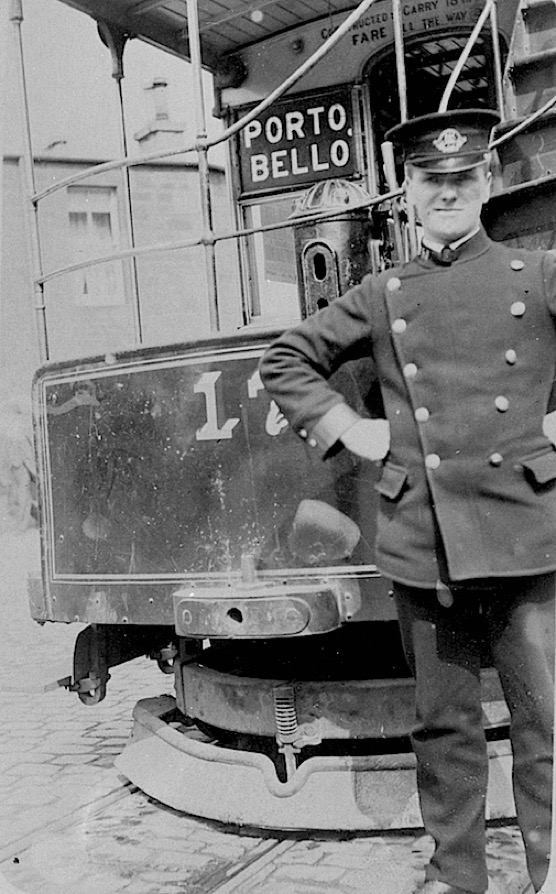
E&DTCo Cable Tramcar No 17 and its driver — photo undated, but probably taken not long before electrification. With thanks to the National Tramway Museum. 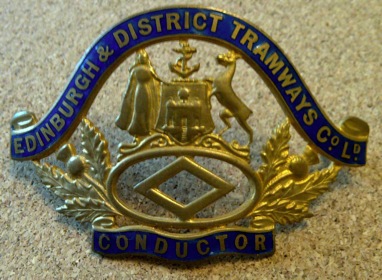
An EDTCo 'CONDUCTOR' cap badge (introduced in early 1913) — brass and blue enamel with a diamond symbol. With thanks to Darren Lodge.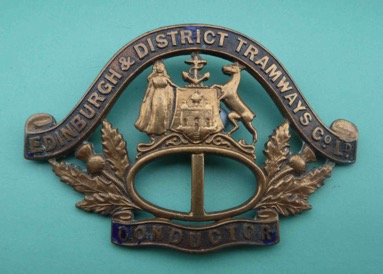
An EDTCo 'CONDUCTOR' cap badge (introduced in early 1913) — brass and blue enamel with a vertical bar symbol. With thanks to Richard Bevington.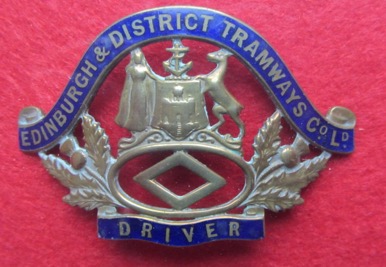
An EDTCo ''DRIVER' cap badge (introduced in early 1913) — brass and blue enamel with a diamond symbol. With thanks to Alan Brotchie.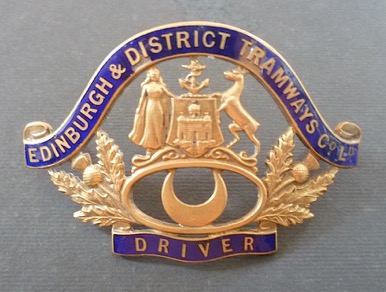
An EDTCo ''DRIVER' cap badge (introduced in early 1913) — brass and blue enamel with a crescent symbol. Author's Collection.
Motormen and conductors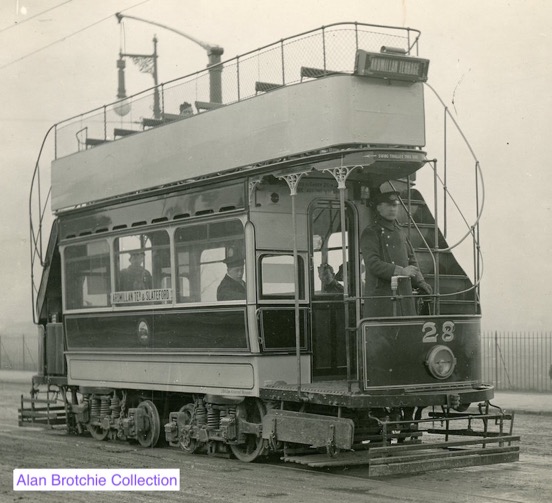
Electric Car No 28 on the E&DTCo's solitary overhead electric line, Ardmillan Terrace to Slateford — photo undated, but probably taken during or shortly after the Great War (a soldier and a sailor are clearly visible).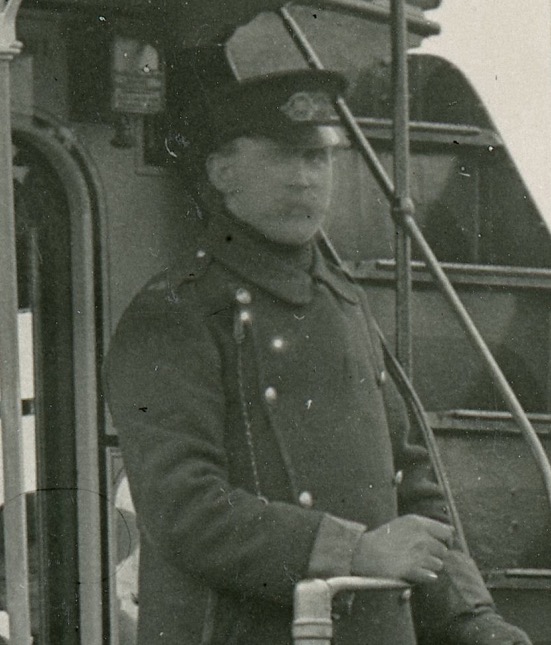
An enlargement of the above photograph showing the motorman. He is wearing an example of the brass and blue enamel cap badge that was introduced sometime prior to the Great War.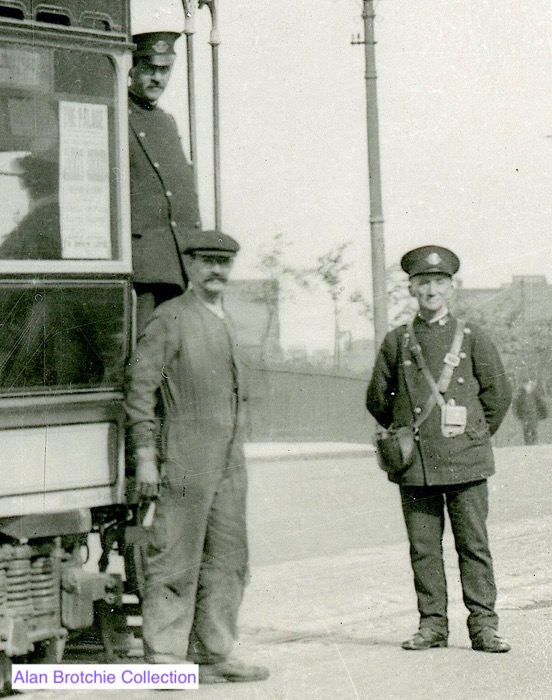
A motorman, a fitter and a conductor with Electric Car No 64.
Senior staff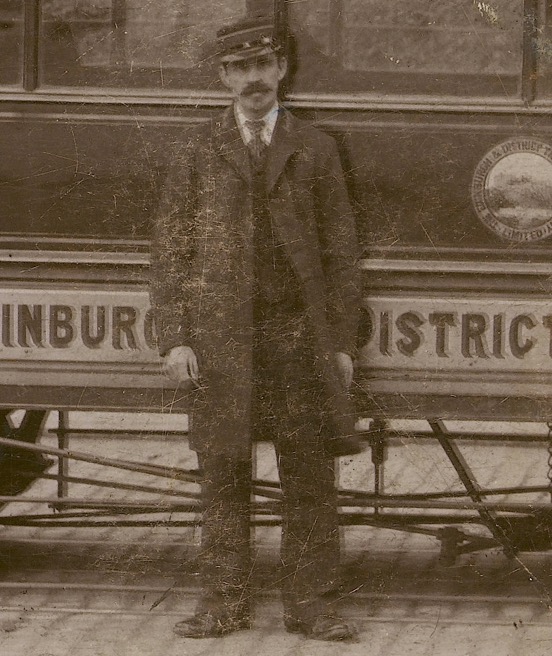
An inspector, taken from the photograph above of an ex-Edinburgh Northern Tramways Co cable tram in Inverleith Row — photo undated, but probably taken in 1897. The subject's collars bear embroidered script-lettering 'Inspector' badges, whilst the cap is devoid of insignia.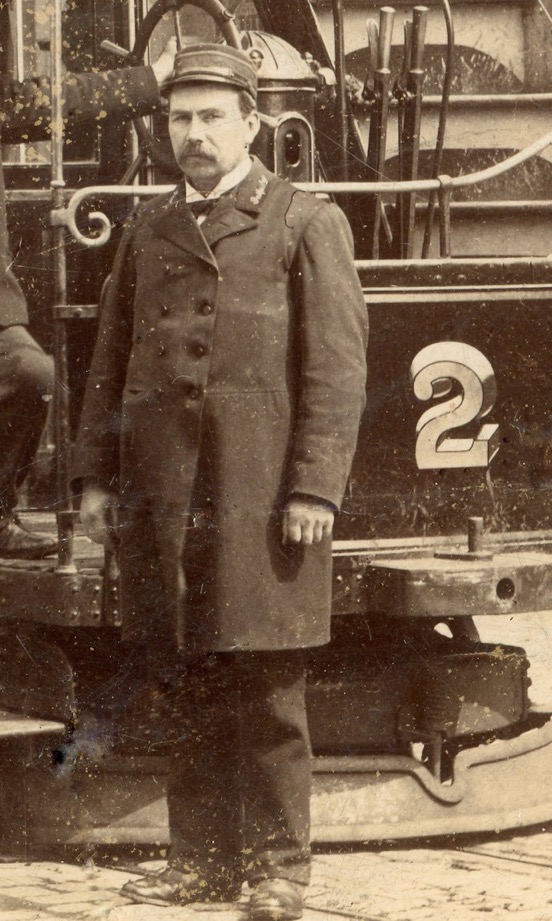
The same uniform was clearly being worn four years later in May 1900 — taken from the same photo as that above showing the crew of Cable Tram No 2 at Marchmont.
Female staff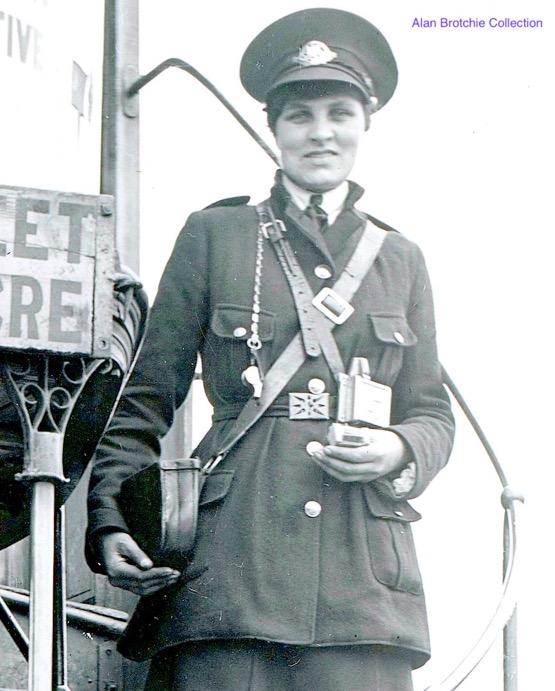
An E&DTCo cable tram conductress — photo undated, but certainly taken during the Great War or shortly thereafter. The cap is in an unusually wide-crowned peaked style, and carries the later period E&DTCo brass and blue enamel cap badge. The belt buckle is certainly unusual, and given that it doesn't appear in any other conductress photos, was probably not standard, possibly military.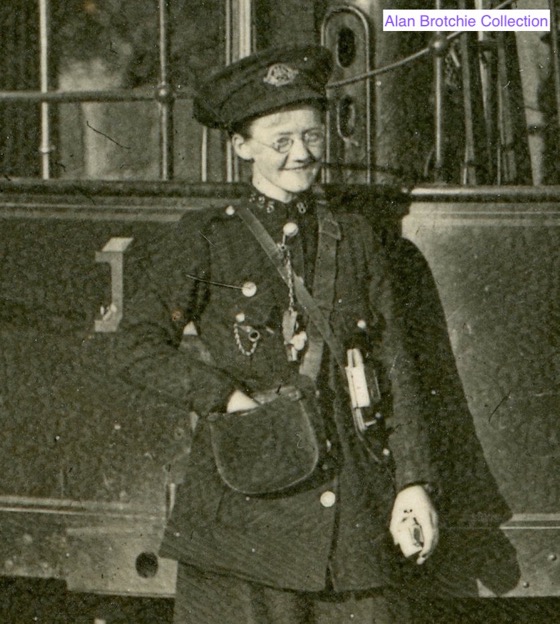
Another shot of a conductress on duty, this time clearly showing that the employee numbers (in this case 825) were worn on both the stand-up collars — dating from the Great War or shortly afterwards. Taken from the same photo as that of Driver 294 above. Her cap badge bears a diamond.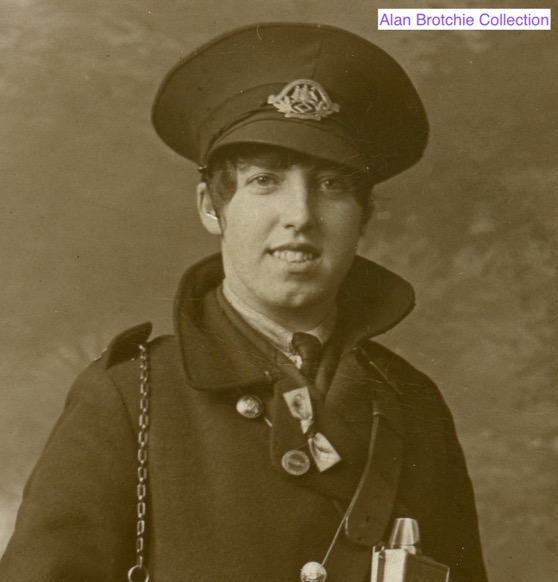
A lovely studio portrait of an E&DTCo conductress, so sharp that even the buttons can be made out on magnification — undated, but certainly taken during the Great War or shortly thereafter. The cap badge on the large crowned cap bears a diamond.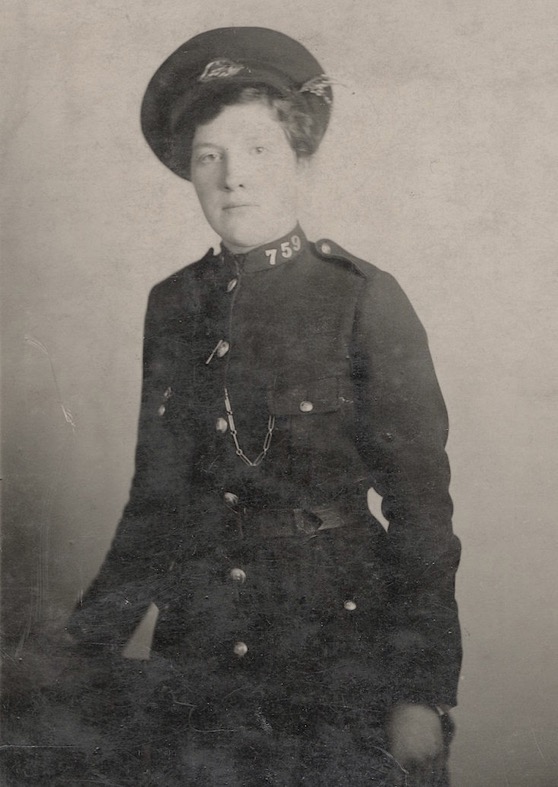
A studio portrait of a Great War E&DTCo conductress (Employee No 759), whose name may possibly have been Janet. Author's Collection.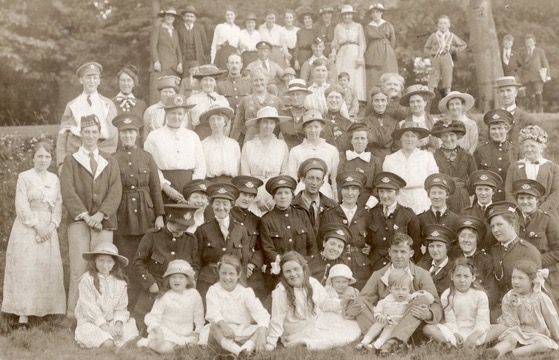
A fine study of E&DTCo tramway ladies, convalescing soldiers and nurses at what is believed to be Craiglockhart — photo undated, but certainly taken during the Great War or shortly afterwards. Employee numbers that can be made out with a reasonable degree of confidence are: 709, 710, 731, 745, 746, 748, 759 and 862. Seven of the ladies have crescent badges, seven have diamonds, and one has a bar. Author's Collection.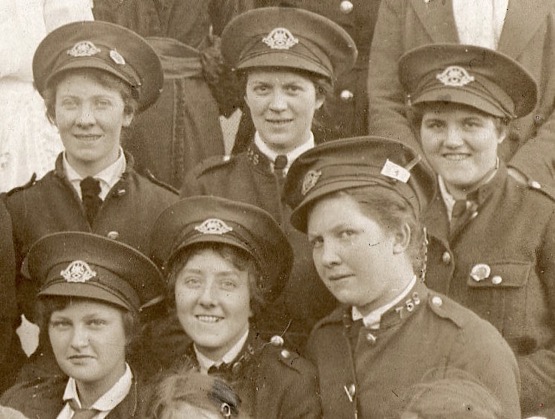
An enlargement of the above photograph showing six of the tramway ladies. Employee No 759 (bottom right) is the same lady in the studio portrait shown above.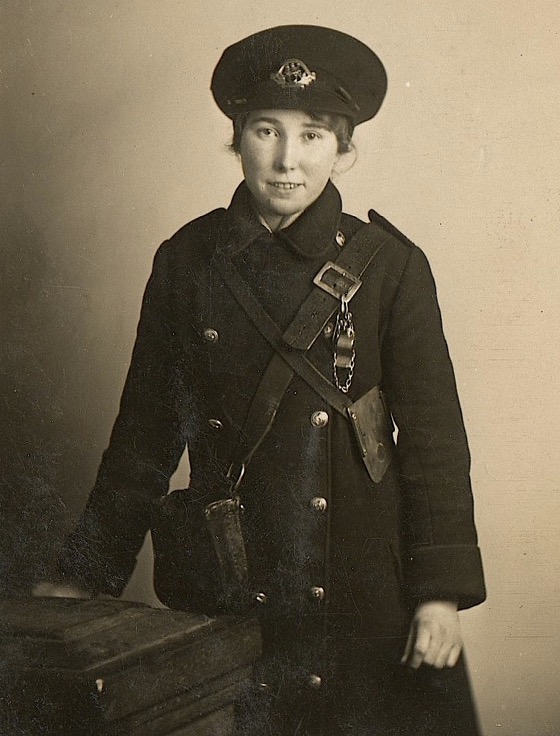
A studio portrait of an E&DTCo conductress — photo undated, but certainly taken during the Great War or shortly thereafter. The badge probably bears a crescent in the centre, though this cannot be made out with certainty. The portrait was taken at Alpine's Studios, 26 Greenside Place, Edinburgh. Author's Collection.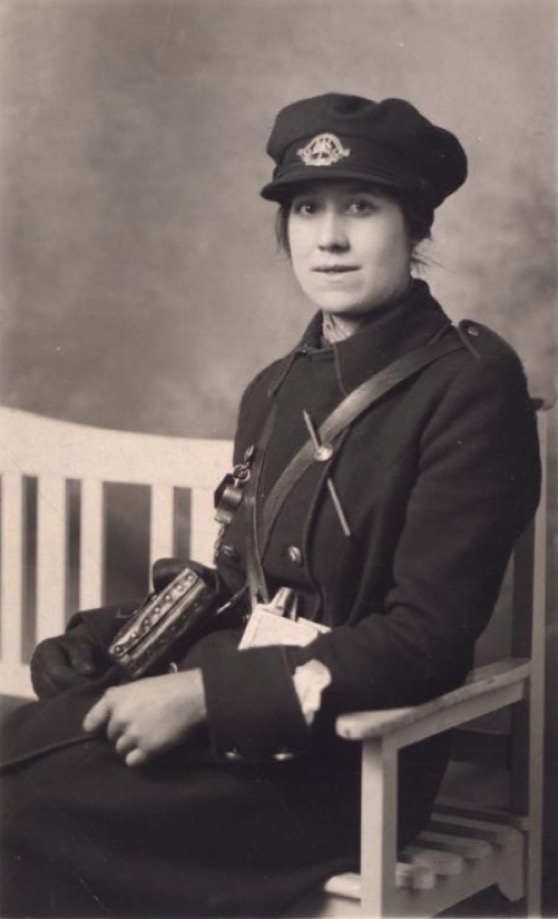
Another charming studio portrait of an E&DTCo conductress — photo undated, but certainly taken during the Great War or shortly thereafter. The badge has a vertical bar in the centre. With thanks to Stephen Howarth.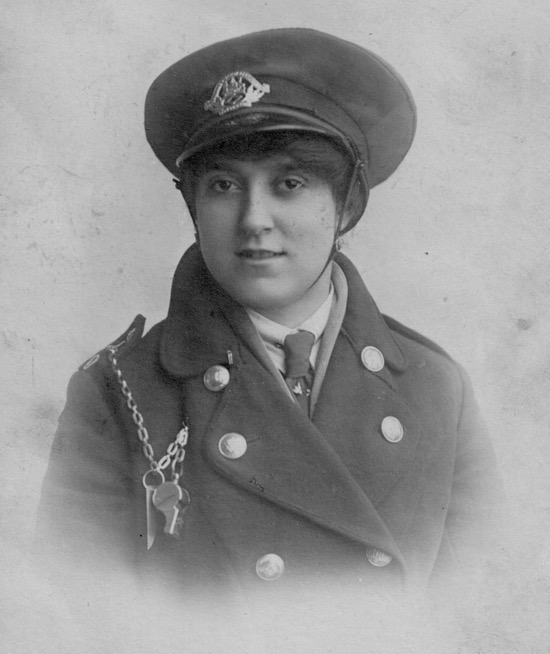
A studio portrait of an E&DTCo conductress — photo undated, but certainly taken during the Great War or shortly thereafter. The badge has a diamond in the centre. Author's Collection.